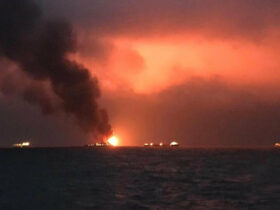Presentation at the WAPE congress.
Presentation at the WAPE congress.
By Halil Özsaraç, Retired Navy Captain, Turkish Naval Forces
The World Association for Political Economy (WAPE) held its 18th annual forum in Türkiye, hosted by Yeditepe University.
The theme of the Forum, held on August 6–8, was “Multipolarity in the 21st Century: Challenges and Opportunities in Political Economy”.
Halil Özsaraç, Retired Navy Captain from Türkiye, made a presentation titled “Possible effects of USA long-term naval preparations on multipolarity”.
We present the written form of Özsaraç’s presentation to our readers.
Introduction
Control of trade routes:
– For the West, it means cheapening the production power of the East and South through the interconnectedness of production centers and markets;
- For the East, it means saving the Eastern labor force from being a toy of the West by making world markets accessible.
The world’s maritime trade routes, which are the main key to maintaining or getting rid of modern slavery, have a hierarchy within themselves. The Eurasian Southern Sea Trade Route, which connects the ports of the Old World, has been at the top of this hierarchy for thousands of years. Due to their relatively lighter loads, the Trans-Pacific, Trans-Atlantic and north-south ocean routes are “secondary level” transportation lines that attempt to integrate into the Eurasian Southern Sea Trade Route.
As Trump was about to take office as US president on January 20, 2025, he has revealed the high strategy of the United States, which seeks direct sovereignty over Canada, Greenland and Panama. Canada and Greenland form the northern and western coasts of the Arctic Ocean. Panama, on the other hand, is a critical waterway that can facilitate military pressure on the entry points to the Arctic Ocean, which exhibits a semi-closed ocean feature, since it can provide inter-oceanic transit with access to the Arctic. To put it more clearly, the Panama Canal, which provides the Atlantic-Pacific passage, offers its owner the ability to create an east-west weight center on the Arctic Ocean in the event of a war. Therefore, Canada, Greenland and Panama are subjects of the indirect strategy that expresses the US goal of military control of the Arctic.
- The US’s demands for the evacuation of Gaza and its temporary giving to its sovereignty, as of February 7, 2025;
- The war waged by the US and/or its proxies for years with the Yemeni Houthis in the Red Sea;
- The attitudes of the United States and its proxy Israel thatforce Iran, which has the ability to control the Strait of Hormuz, to use a new generation of weapons,
– The establishment of a logistics corridor between the Baltic Sea and the Eastern Mediterranean following the establishment of the “Three Seas Initiative” in Eastern Europe, with US encouragement, and the conduct of numerous military exercises testing the use of this corridor;
- The gradual increase of the US military presence in Greece and Southern Cyprus,
constitute another indirect strategy of the US high strategy, which aims to maintain control of all the West Asian seas, primarily the Eastern Mediterranean.
The ice ocean that is approaching to becoming a warm semi-enclosed ocean: The Arctic
The ice of the Arctic Ocean, which is 5 times the size of the Mediterranean Sea and 1/6 of the Indian Ocean, melts at a rate of 12.85% every 10 years. Therefore, from the 2040s onwards, the parts of the Arctic Ocean near the Russian coasts will become an efficient and busy maritime transport line that will cross Eurasia and America from the north. Russia, which has been pushed from the seas to the land by the imperialist West for centuries, will have a busy maritime trade route that it can control in the 2040s. In short, unless there is effective intervention from the West, Russian maritime geopolitics in 20 years will have reached a level of power that could break the lock of today’s imperialist world order. To use an analogy, the Arctic Ocean is still the snowball stage of an avalanche that will fall on the current global imperialism of the United States in 20 years. Sweden and Finland’s membership in NATO is also one of the early measures for the Arctic Sea Route, which is a newborn geopolitical baby.
Bringing Sweden and Finland, who have become US allies in Arctic policies, into play through NATO does not mean that the US will conduct its future Arctic struggle through NATO. As a matter of fact, the United States claimed Greenland Island on the Arctic-Atlantic connection from its ally Denmark by restitution. After that, the United States invitedCanada, another ally and its favorite trading partner, which owns theArctic’s neighboring coasts to Russia along with its 36,500 islands, to come under its federal sovereignty. Following this, the United States argued that the Panama Canal was its own property.
As can be seen, the USA, which wants direct sovereignty over the future critical geographies through a restitution with Denmark, Canada and Panama, shows that it does not trust either NATO or its satellites in the Arctic conflict it will engage in with Russia in 20-30 years. This is also proof that NATO is a loose defense and security alliance.
The meaning of “multipolarity” and the “Belt and Road Initiative”: Asia wants to take back control of the Eurasian Southern Sea Trade Route from imperialism
Russia, which has been unable to reach out and access the geopolitical power opportunities of busy oceans and seas for centuries, must wait another 20 years to achieve the geopolitical power it desires, thanks to global warming. In this 20-year future that worries imperialism, the coastal areas of the ancient trade routes passing through the south of Eurasia, that is, their original owners, are also making preparations to get rid of imperialism. To summarize;
– China, which the US is trying to contain together with its allies and partners in the Asia-Pacific, has been able to prepare a navy capable of breaking this powerful chain around it and has begun infrastructure preparations to transform the trade ports it currently operates into future Chinese overseas bases. While China is not ready for the distant West Asian seas, it is ready for oceanic struggle in the adjacent Asia-Pacific.
- The West Asian states, such as Türkiye, Egypt, Iran, and the Gulf Arab states, which are oppressed by imperialism, are waiting for multipolarity to become more pronounced so that they can use their potentially unified geopolitical power in the fight against the West. If they overcome the chaotic, indirect and manipulative interventions of imperialism, it is an option that can end the imperialist presence on the Eurasian Southern Sea Trade Route if the West Asian states join their geopolitical forces provided by the narrowing sea routes.
If we interpret the situation summarized above from Russia’s perspective, it should not be forgotten that Russia is obliged to prepare its navy for the Arctic Ocean 20 years from now, rather than the Mediterranean Sea. In other words, the Russian Navy’s support for the struggle that West Asian states will have to wage with US imperialism for their own seas in the future will be quite limited.
The US anticipates that it will have to fight a similar struggle against West Asian states on the critical choke points in the south of the Old World as it will fight against Russia in the Arctic Ocean. For this reason, the US, on the one hand, is trying to make the war infrastructure suitable for semi-closed seas, and on the other hand, has embarked on a geopolitical space initiative struggle in critical areas of the West Asian coasts, especially in the Eastern Mediterranean. In particular, the coasts and islands of Greece, the southern coasts of Cyprus and the coasts of Gaza are intended to be transformed into critical geographies that will host the US’s overseas military power.
Imperialist manipulations in the Eastern Mediterranean aim to distract Türkiye
It was noteworthy that the Greek Administration of Southern Cyprus (GASC) presented a plan to the US regarding the possible NATO membership of the GASC at the end of 2024. This should be seen as a new phase of the US’s long-term Mediterranean policy. In other words;
– The US’s continued efforts to bring its NATO-integrated capabilities and critical operational infrastructure to Cyprus,
- Western imperialism’s renewed proposals for a “United Cyprus” and its offer of a US or NATO guarantor role instead of Türkiye,
demonstrate that the US is attempting to shape the Eastern Mediterranean militarily and politically. The reason why the US attaches importance to Cyprus is that it is the best and safest geography where long-range weapons can be positioned against all transportation choke points in the West Asian seas.
In the early 2000s, the imperialist West used the Russian military activities in the Eastern Mediterranean and the Middle East as an excuse for its extraordinary military infrastructure works in the south of Cyprus. However, Russian naval activities in the Eastern Mediterranean were too weak to be used as an excuse.
Thereupon, attempts were made to link the West’s excessive naval presence in the Eastern Mediterranean with the escalating maritime jurisdiction disputes between Türkiye and the Greece-Greek Cypriot Administration alliance and the hydrocarbon deposits in these areas. Pushed into the West’s energy-political blackout spiral, Türkiye has been forced to prioritize jurisdictional struggles over the security of the vital Eurasian Southern Sea Trade Route in its Eastern Mediterranean policies over the last 20 years. However, in recent years, Türkiye has turned to moderate policies that have surprised even the West, and the new excuse for the presence of Western navies in the Eastern Mediterranean has become to take precautions against regional instability caused by Israel.

Compensation for the temporary downsizing in the evolving US Navy: Deploying tactical missile systems on the coasts of Asia
The older Ticonderago-class cruisers, each equipped with 122 vertical launch modules (VLS), are the most prolific U.S. surface warships capable of carrying both ship-to-land Tomahawk cruise missiles and ship-to-space SM-3 missiles. Despite their dazzling firepower, all of the current 12 Ticonderago-class cruisers will be decommissioned before 2029. The decommissioning of the Ticonderago-class cruisers means that the US Navy will lose 1,464 Tomahawk or SM-3 launch modules from its current total of approximately 10,000 in the next three years.
The “firepower decline” problem that plagues the US Navy is not limited to cruisers; a similar problem is also experienced in nuclear submarines. Designed to launch nuclear ballistic missiles from underwater, the oldest four of the 18 Ohio-class nuclear submarines were renovated between 2002 and 2008 and each was made capable of launching 154 Tomahawk cruise missiles. These four Ohio-class nuclear submarines, which have been given the ability to launch Tomahawk cruise missiles instead of ballistic missiles, will be decommissioned in 2026 and the other two in 2028, as they are now in their 40s. In other words, the number of Tomahawks the US Navy can launch underwater will be reduced by 616 after 3 years.
The fact that the US Navy will experience a decrease in its ability to launch a total of 2,080 long-range missiles over the next 3 years, including 1,464 from surface warships and 616 from submarines – which corresponds to a decrease of approximately 20%- has become a topic of discussion in the US. At the seminar organized by the Center for Strategic and International Studies (CSIS) in Washington DC on October 8, 2024, Vice Admiral James Pitts of the US Navy and many American strategists sought the answer to the following question: “If the US Navy will be decommissioning 16 warships capable of firing long-range missiles within three years, will the remaining US warships and their vertical launch modules be sufficient?”
In the aforementioned seminar, some solutions were sought to compensate, at least partially, for the “decrease in firepower in action on the seas and oceans.” Among them, there was another proposal that attracted attention, in addition to constantly supplying weapons and ammunition to ships in the operational area with unmanned ships and submarines: “To position the vertical launch modules and missiles removed from the decommissioned ships in offshore ‘coastal’ areas, particularly in the ‘near island chains’ located in the vicinity of the target areas…”
In summary, the US is discussing the deployment of 2,080 long-range and high-tech missile (Tomahawk/SM-3) launch modules that it will dismantle from scrap warships, on the “chain of islands” and “near coasts” near threatened countries such as Türkiye, China, Russia, Iran, North Korea and Yemen…” It is still unclear whether the “island chain” under discussion will include Taiwan, Japan, Crete, Cyprus, even the Aegean Islands, as well as the islands in the Red Sea, the Yemen Sea, and the Persian Gulf; and whether the “nearby coasts” will include Djibouti, Western Thrace, South Korea, and some or all of the coasts of Saudi Arabia or Gaza, from which Trump wants to expel Palestinians.
Is the 2054 US naval construction program a preparation for World War III and IV?
The US Congressional Budget Office has calculated the average annual budget to be allocated for the large-scale warship building program, which will last from 2025 to 2054, at $ 40.1 billion. The aging US Navy, currently consisting of 296 manned warships, will be rejuvenated and comprised of a total of 515 warships, 381 manned and 134 unmanned, by 2054. US Navy documents state that in 30 years, they aimed to:
– To achieve more spread-out firepower than today,
- To gain greater offensive capabilities based on longer-range missiles and more unmanned (robotic) systems than today, and
- To transform the US Navy into a more difficult-to-destroy force.
According to the US budget studies updated in January 2025, a total of 364 new manned warships will be built for the US Navy, which will consist of 381 manned warships after 30 years, 293 of them will be main combatants and 71 in logistics and support roles in the next 30 years, and about 1.2 trillion dollars will be allocated from the US budget for this. Six of these ships will be built in 2025; 51 in the 4-year period between 2026 and 2029; and the remaining 307 in the 25-year period between 2030 and 2054. In 2025, the United States has launched a very ambitious program to build an average of 12 manned warships per year.
The fuzziest part of this ambitious program is the unmanned ships. Of the 134 medium, high and very high tonnage unmanned vessels to be built within 30 years; 40 will be “large, unmanned surface vessels” (LUSV), which will serve as an auxiliary role in the transfer of ammunition to manned warships. The first of the “large, unmanned surface ships” (LUSVs), which are expected to have a service life of 20 years, will be delivered to the US Navy in 2027, and the number of these large-tonnage unmanned ships will increase to 31 in 2045 and 40 in 2050. The numbers and construction programs of the “medium-tonnage unmanned surface vessels (MUSVS), which will be used only in the connaissance-surveillance role through their sensors, and the “extra-large unmanned submarines”, which will be designed for use in dangerous areas of operations, without warning, and for transporting large amounts of war materials, have not yet been announced.
While alternative programs are being discussed for the construction of 290, 299 or 340 new manned warships within a 30-year plan before January 2025, the number of manned warships to be built in the last announced new shipbuilding program has been increased to 364 in 30 years.
Table: 30-Year U.S. Naval Construction Program Updates Comparison Before and After 2025
| Ship Type | Number of Ships to be Built in Pre-2025 Optional Programs | Number of Ships to be Built in the 2025 Program |
| Aircraft carrier (Unit cost: $16.5 billion) | 6-7 | 6 |
| Ballistic Missile Launching Nuclear Submarine (Unit cost: $9.4 billion) | 11 | 10 |
| Tomahawk Launching Nuclear Submarine (Unit cost: $10.4 billion) | 4 | 6 |
| Virginia-Class Nuclear Submarine with Tomahawk Launching Capability (Unit cost: $5.1 billion) | 11 | 9 |
| Virginia-Class (SSN-774) Nuclear Submarine with Non-Tomahawk Launching Capability (First to be ready in 2029) (Unit cost: $5.1 billion) | 10-37 | 36 |
| Next-Generation Offensive Nuclear Submarine-SSN(X) (First to be ready in 2049) (Unit cost: $8.7 billion) | 18-35 | 14 |
| DDG-51 Flight III destroyer (Unit cost: $2.7 billion) | 18-20 | 23 |
| Next-Generation Destroyer-DDG(X) (First to be ready in 2039) (Unit cost: $4.4 billion) | 30-46 | 28 |
| FFG-62 Frigate (First to be ready in 2029) (Unit cost: $1.4 billion) | 10-16 | 24 |
| FFG-62 Flight II Frigate (First to be ready in 2041) (Unit cost: $1.4 billion) | 37-46 | 57 |
| LHA Amphibious Assault Ship (Unit cost: $4.8 billion) | 4-6 | 8 |
| LPD-17 Flight II Amphibious Dock Ship (Unit cost: $2.2 billion) | 0 | 5 |
| Next-Generation Amphibious Dock Ship-LPD(X) (First to be ready in 2045) (Unit cost: $2.8 billion) | 5-10 | 12 |
| Medium-Tonnage Amphibious Landing Ship (First to be ready in 2029) (Unit cost: $0.4 billion) | 36-51 | 55 |
| Logistics Support Ships (Unit cost: $0.5-1.1 billion) | 53-73 | 71 |
| TOTAL | 290-340 | 364 |
Today, the US Navy has 11 aircraft carriers, 10 of which are Nimitz-class and 1 Ford-class. The US Navy, which will not be able to acquire a new aircraft carrier until 2030, will have a new Ford-class aircraft carrier enter its inventory every 4-5 years after 2030, as can be seen in the table above. According to this shipbuilding program, it is possible for the United States to maintain the number of aircraft carriers at 11 by the end of 2036. However, due to the fact that some Nimitz-class aircraft carriers are in their 50s, the number of aircraft carriers in the US Navy will fluctuate between 10 and 11 between 2037 and 2046; after that, the US will have to make do with a total of 8 or 9 aircraft carriers, including 7 Fords and 1 or 2 Nimitz-class carriers that will be extended through expensive renovations despite being in their 40s. In fact, it is also possible to understand that the number of aircraft carriers will decrease to 8-9 in 21 years, as the construction rate of destroyers, whose main duty is to escort aircraft carriers, will be reduced in 2038. To put it concretely, the construction rate, which is 2 destroyers/year until 2037, will be permanently reduced to 1.5 destroyers/year after 2038.
To summarize, the US’s power in the oceans will be weakened by 20-25% in order to use its defense industry in favor of the naval force it will build for semi-enclosed seas. It should not be forgotten that the US, although somewhat weakened, can use its war power in the oceans to stop Asian combat or logistics support platforms that seek to transit from the oceans to semi-enclosed seas.
The number of US nuclear attack submarines, currently 48, will decline to 47 in 2028, and with 59 new nuclear attack submarines to be built within 30 years, this number will jump to 66. In other words, the United States will have a nuclear attack submarine fleet that is 37.5% more powerful in 2054 compared to today. The US’s efforts to increase the number of nuclear attack submarines that it can use in both oceans and semi-enclosed seas may be aimed at isolating semi-enclosed seas from the oceans in case of war, or it may be aimed at breaking the naval resistance of all Asian states, including Türkiye, underwater, which is a semi-asymmetric environment.
The construction rate of new-generation frigates, which will be built for the US Navy and are the most suitable combat platforms for semi-enclosed seas, will remain at 1.5 per year between 2029 and 2030, but will be fixed at 3 per year from 2031 to 2054. The fact that the delivery date of the first Constellation-class frigate (FFG-62), which the United States plans to put into service in 2025, to the US Navy has been postponed to 2029, means “earned time” for Asia. The US plans to acquire an “abnormal number” of 81 of these modern frigates by 2054.
Having built only 3 large-tonnage amphibious ships between 2018 and 2024, the USA will enter a frenzied amphibious shipbuilding process starting in 2027, after building 3 more large/medium-tonnage amphibious ships in the 2-year period of 2025-2026. The US Navy will average a construction rate of 3 ships/year for large/medium tonnage amphibious ships in the 15-year period between 2027 and 2041. It is planned that the United States will reduce its amphibious ship construction rate to 1 ship/year in the 4-year period between 2042 and 2045, suggesting a clear period of peace, and to increase it to 3.1 ships/year in the 9-year period between 2046 and 2054.
The US plans to build 46 of the planned 71 logistics support ships in the 12-year period between 2026 and 2037; one in 2042; and the remaining 24 in the 11-year period between 2044 and 2054. It may be due to the fact that the US will not build any logistics ships between 2037-2041 and 2043, having planned the period between 2037-2044 as a “Deceptive period of peace”.
When the US Navy shipbuilding program, which was updated at the beginning of 2025, is examined in general, the conclusion that can be reached regarding the imperialist US’s future intentions is quite clear – since there are not many options: “For the next 30 years, the US is preparing for a ‘world war’ in the semi-enclosed seas of the Mediterranean, Red Sea, Persian Gulf, Black Sea, and Baltic Sea, as well as the Arctic Ocean (a semi-enclosed mini ocean), and the Yemen Sea, Oman Sea, North Sea, and Bering Sea, which control the entrances and exits of these sea areas.”
In particular, the excessive importance given to amphibious shipbuilding shows that the United States will need extensive coastal invasions, and for this it will not stop from amphibious operations, the type of operation in which “human loss is the most intense”. It should not be forgotten that a US operation that wants to be carried out in the Seas of Western Asia can be supported from the oceans and the Baltic Sea.
Conclusion
Today, the United States does not like to have its navy, designed for the oceans, operate in semi-enclosed seas; it prefers to protect its interests in such narrow seas by using its proxies. The US predicts that in a future where multipolarity becomes more pronounced:
- The chain of alliances and partnerships it has been able to establish through chaotic “proxy wars or tensions” will be shaken.
- Containing China closely will fail, and therefore it will be forced to surround China from afar by taking full control of the transportation hubs of Eurasian maritime trade routes.
- The West Asian states, freed from the West’s proxy under the influence of multipolarity, will unite and risk war with the US for the sake of re-owning the West Asian seas that carry the golden maritime triangles,
- It will be forced to fight Russia for the Arctic maritime trade route, which will become busiest in the 2040s. In the face of rising Asia and the reality of multipolarity, the 30-year shipbuilding program prepared by the United States, which will need wars during the periods when it will be most ready, contains clues about the place and time of future imperialist wars.
In a war scenario in the West Asian Seas, it should be expected that Western European states, due to their import dependence on China, may initially choose to remain “neutral,” but if the war drags on, they may be forced to support West Asian states (and China) in order to keep their economies afloat.
It is noteworthy that the updated long-term US naval construction program will halt/slow down amphibious shipbuilding activities between 2041 and 2045, and logistic support shipbuilding activities between 2037 and 2044.
This situation shows that the United States is acting with the doctrine of two world wars in two separate areas of operations, at two separate times over the next 30 years. Due to the fact that the Arctic needs a little more time to turn into a busy trade route; the naval areas where the United States is primarily preparing for war are the West Asian seas.
Considering the slowdowns and accelerations in the shipbuilding program, it appears that the US is preparing, on its own initiative, to start a world war in the Eastern Mediterranean between 2035 and 2037, and another world war in the Arctic Ocean between 2045 and 2054. Therefore;
- Asian states should;
* Without wasting time, join forces and cooperate.
* By 2035, they should undertake symmetrical, primarily corvette-based, semi-symmetrical, and primarily mine-based, preparations in the semi-enclosed seas of West Asia; and joint construction of numerous, high-quality manned/unmanned naval platforms with high firepower.
* They should jointly manage, develop, and train air, sea-air, and space forces.
- After isolating the seas of West Asia from imperialism, all Asian navies should prepare for potential wars in more northern latitudes. After 2045, they should launch a powerful presence in the oceans, and all maritime trade routes around Eurasia, starting with the Arctic, should be cleared of imperialist influence.

















Leave a Reply